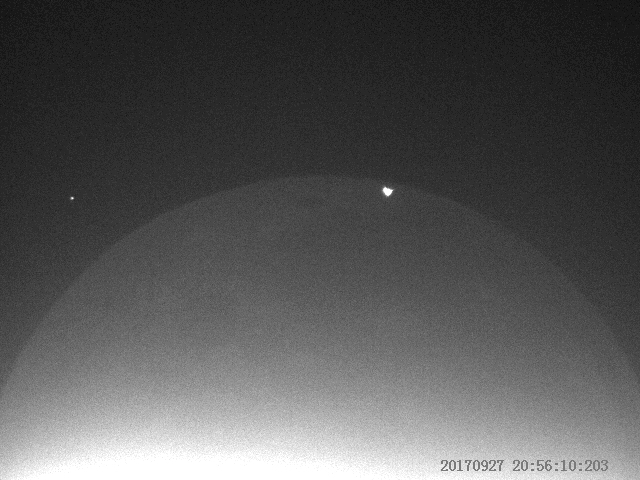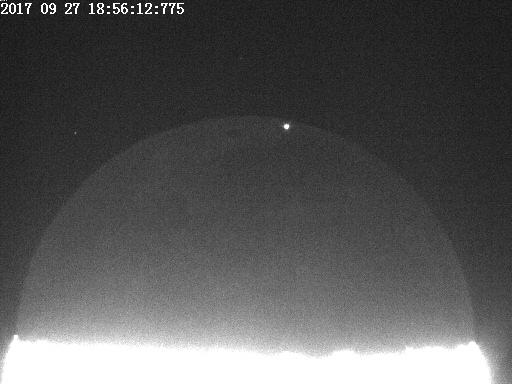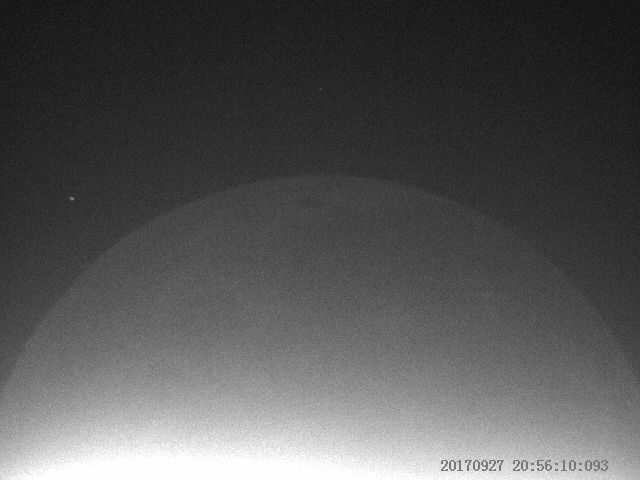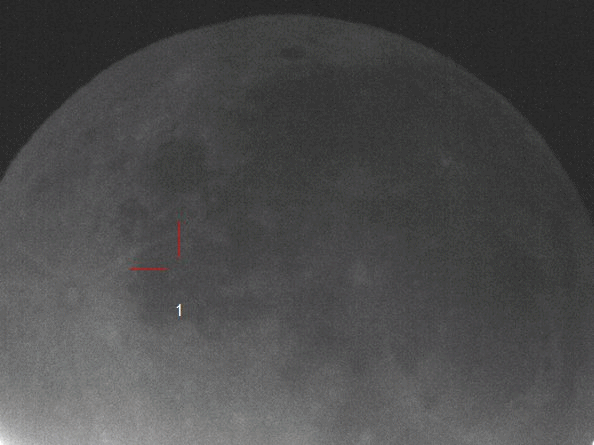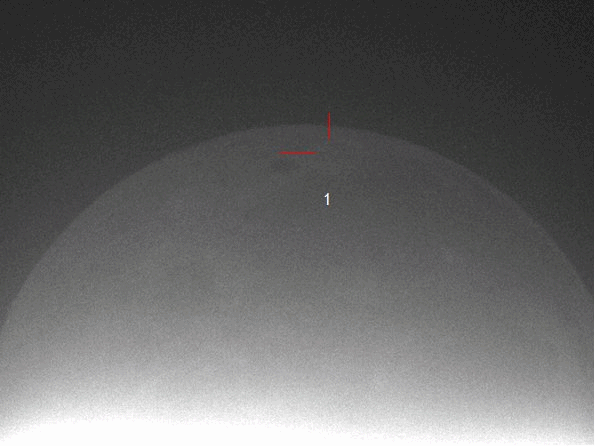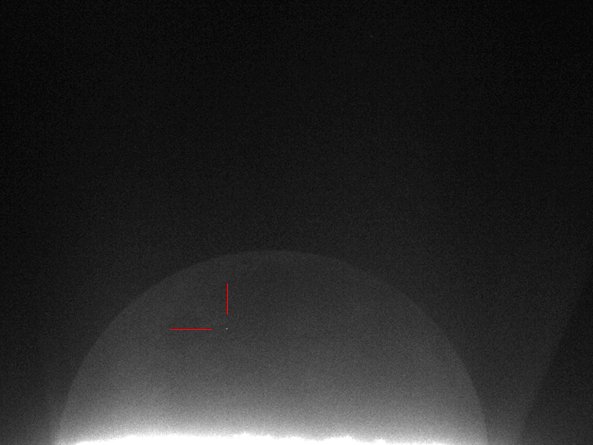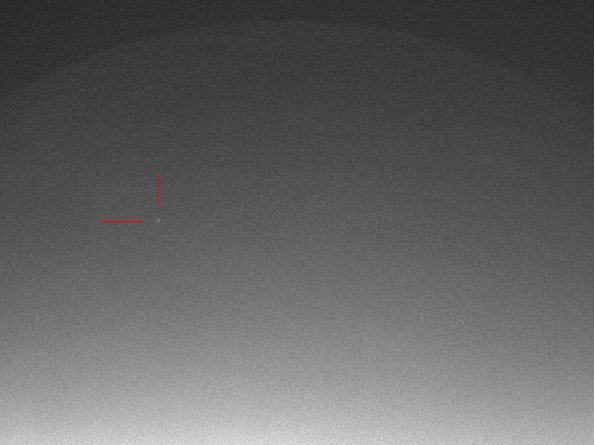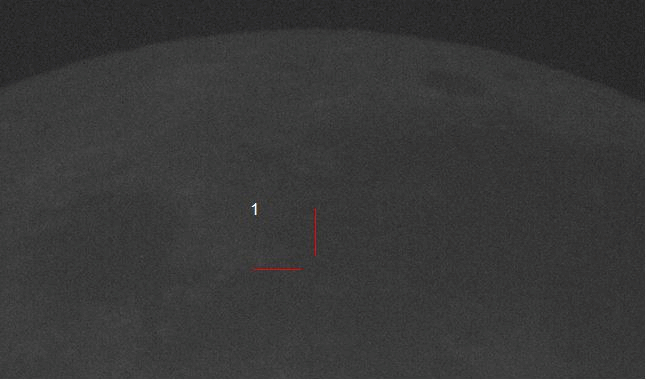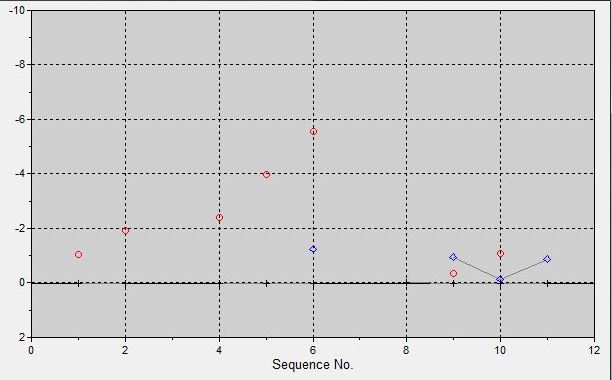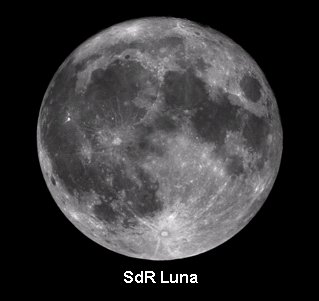Lunar Impact Candidates recorded
5° Lunar Impact Candidate recorded by SNdR Luna UAI
A new important flash of an impact meteoroid on the lunar surface has been observed and recorded on 2017 September 27 at 18h 56m 12s UT by the members of Sezione Nazionale di Ricerca Luna UAI Bruno Cantarella and Luigi Zanatta from the observative site of Melazzo, AL, Italy, 44°39'25" North, 8°25'52" East. The observation and record of the impact flash has been made at the same time by two differents telescopes, the first a Newton telescope 200/1000 with a focal reducer at f/2.9 with astronomical videocamera ZWO mod. ASI 120MM with image resolution of 640x480 with binning 2x2 at frame rate of 25 fps, and the second a Newton telescope 100/400 at f/4 with an other identical astronomical videocamera ZWO mod. ASI 120MM with image resolution of 512x384 with binning 2x2 at frame rate of 30 fps. At the moment of observation and record of impact flash both the telescopes was installed in parallel mode on one equatorial mount EQ6 Skywatcher.
INSERIRE SPIEGAZIONI IMMAGINI
Il flash al picco di luminosità ripreso dal telescopio Newton 200/1000 ad f/2,9
Il flash al picco di luminosità ripreso dal telescopio Newton 100/400 ad f/4
Di seguito è invece pubblicata l’animazione in formato gif del flash da Impatto ripreso dal telescopio Newton 200/1000 ad f/2,9 e la sequenza è stata composta con 23 frame ed il tempo di inizio del primo frame della sequenza è 20:56:10:093 (N.B. qui il tempo del timestamp è espresso in Ora Estiva).
Sequenza animata del flash ripreso dal telescopio Newton 200/1000 ad f/2,9
E' stata poi ricavata la posizione selenografica del flash da Impatto e le coordinate selenografiche ottenute sono alla Latitudine 8,0° Nord e Longitudine 76,5° Ovest, +/-1° su entrambe le coordinate selenografiche, e la zona lunare dell’impatto è stata individuata ad Est del cratere Glushko, a circa 20 km di distanza dal bordo Est del cratere.
Come per i precedenti Candidati Impatti già registrati dagli stessi membri della Sezione è stato effettuato il consueto invio dei dati osservativi al Marshall Space Flight Center della NASA che si occupa a livello professionale per la raccolta dei dati sugli Impatti Lunari dove il Team dei ricercatori statunitensi ha valutato in modo molto positivo il risultato ottenuto, e quindi i risultati saranno pubblicati sul rispettivo sito web dello stesso Centro NASA competente in materia.
4° Lunar Impact Candidate recorded by SdR Luna UAI
A new flash of an impact meteoroid on the lunar surface has been observed and recorded on 2017 January 1 at 17h 47m 07s UT by the members of SdR Luna UAI Bruno Cantarella and Luigi Zanatta from the observative site of Melazzo, AL, Italy, 44°39'25" North, 8°25'52" East. The observation and record of the impact bright phenomenon has been made by a unique Newton telescope 200/1000 with a focal reducer at f/2.9 with astronomical videocamera ZWO mod. ASI 120MM at frame rate of 25 fps, with image resolution of 640x480 binning 2x2. The telescope at the moment of observation was installed on equatorial mount EQ6 Skywatcher. Also the same flash Impact has been observed and recorded and therefore confirmed by the Dott. Tony Cook of the BAA. After the send of the observativies date by the Lunar Impact Project Coordinator of SdR Luna to NASA Marshall Space Flight Center, as in the case of the previous Impact Candidate recorded by the same members of our Lunar Section, the Team of American researchers has valued in positive mode the result obtain and has classified the new flash as Lunar Impact Candidate n° 31 in the list of Independent Observers of NASA Meteoroid Environment Office . From the analysis made always by the Lunar Impact Project Coordinator of SdR Luna, the duration of the phenomenon has been about 0.04 seconds (0.4 tenths of second), and the impact zone has been located at the selenographic coordinates of 18.2° West and 21.6° South +/-0.5° in the lunar zone at North-North-East of Wolf A crater, and at South of Gould B crater. The image visible below show the impact flash sequence indicate by two red lines.
The Impact flash taken by Bruno Cantarella and Luigi Zanatta (Melazzo, AL, ITALY), Newton 200/1000 f/2,9 with videocamera ASI 120MM
3° Lunar Impact Candidate recorded by SdR Luna UAI
On 2016 November 6 at 17h 43m 12s UT the members of SdR Luna UAI Bruno Cantarella and Luigi Zanatta (Melazzo, AL, Italy, 44°39'25" North, 8°25'52" East) have recorded the third flash of meteoroid impact on the lunar surface. The observation and record of this impact flash has been made with one telecope Newton 200/1000 f/2.9 with astronomical videocamera ZWO mod. ASI 120MM at frame rate of 25 fps and image resolution of 640x480 binning 2x2. The telescope at the moment of observation was installed on equatorial mount EQ6 Skywatcher. At this moment the Impact Candidate it is not confirm by others independent observers. After the send of the observativies date by the Lunar Impact Project Coordinator of SdR Luna to NASA Marshall Space Flight Center, as in the case of first and second Impact Candidate recorded by the same members of our Lunar Section, the Team of American researchers has valued in positive mode the result obtain and has classified the new flash as Lunar Impact Candidate n° 30 in the list of Independent Observers of NASA Meteoroid Environment Office . The phenomenon is last about 0.08 seconds (1/12 sec.) and the impact zone has been located at the selenographic coordinates 74.5° Ovest and 2.2° North +/-0.5° in the lunar zone to North of Grimaldi, and more precisely at South of Hedin F crater and to North-North-East of Riccioli H crater. The image with the impact flash sequence indicate by two red lines is publish below.
The Impact flash taken by Bruno Cantarella and Luigi Zanatta (Melazzo, AL, ITALY), Newton 200/1000 f/2,9 with videocamera ASI 120MM
2° Lunar Impact Candidate recorded by SdR Luna UAI
On 2016 June 12 at 20h 26m 59s UT the members of SdR Luna UAI Bruno Cantarella and Luigi Zanatta (Melazzo, AL, Italy, 44°39'25" North, 8°25'52" East) have recorded the second flash of meteoroid impact on the lunar surface. The observation and record of impact flash has been made with two different telecopes, Newton 100/400 f/4 and Newton 200/1000 f/5 with two astronomical videocamera ZWO mod. ASI 120MM at frame rate of 25 fps and image resolution of 640x480. Both the telescopes at the moment of observation was installed on only equatorial mount EQ6 Skywatcher. At this moment the Impact Candidate it is not confirm by others independent observers. After the send of the observativies date by the Lunar Impact Project Coordinator to NASA Marshall Space Flight Center, as in the case of first Impact Candidate recorded by the same members of SdR Luna UAI on 2016 March 12, the Team of American researchers has valued in positive mode the result obtain and has classified the new flash as Lunar Impact Candidate n° 29 in the list of Independent Observers of NASA Meteoroid Environment Office . The phenomenon is last about 0.04 seconds (1/24 sec.) and the impact zone has been located at the selenographic coordinates 37.0° Ovest and 10.5° Sud +/-0.5° always in the southern zone of Oceanus Procellarum, and more precisely at South-East of Scheele crater. The two images with the impact flash indicate by two red lines are publish below, and the flash has been taken by two different telescopes. used for the observation and record.
The Impact flash taken by Bruno Cantarella (Melazzo, AL), Newton 100/400 ad f/4 with videocamera ASI 120MM
The same Impact flash taken by Luigi Zanatta (Melazzo, AL), Newton 200/1000 ad f/5 with videocamera ASI 120MM
First Lunar Impact Candidate recorded by SdR Luna UAI
In the animated image it is visible the sequence of impact flash, with the peak in the frame 2 and in decreasing luminosity in the frame 3
On 12 March 2016 at 18h 33m 02s UT the members of UAI Lunar Section Bruno Cantarella and Luigi Zanatta (Melazzo, AL, Italy, 44°39'25" North, 8°25'52" East) have recorded the first flash of impact of one meteoroid on the Lunar surface. The observation and the record has been made with one unique Newton telescope 200/1000 at f/5 with astronomical videocamera ZWO mod. ASI 120MM with a frame rate of 25 fps and image's resolution of 1024x600. Currently the Impact Candidate has been not confirmed by others indepedent observers. After the send of observatives data by the Lunar Impacts Project's Coordinator to NASA Marshall Space Fligth Center, the American Team has valued in positive mode the obtained result and has classified the flash as Lunar Impact Candidate n° 28 in the list of Independent Observers of NASA Meteoroid Environment Office. Also has been made by Dott. Alessandro Marchini Responsible of Astronomical Observatory of the University of Siena (Italy) a first light curve of impact flash that at the moment of the luminosity peak has been 250 units more bright than lunar surface around at the impact zone. The phenomenon it is lasted 0.08 seconds (1/12 sec.), and the impact zone has been detected at the selenographics coordinates of 39.9° West and 8.0° South +/-0.5°, in the southern zone of Oceanus Procellarum, and more precisely to South-West of the crater Wichmann B.
The sequence of the impact flash obtained with analysis software LunarScan 2.00
The light curve of the flash obtained with MaxIm DL5 software
